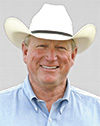Animal welfare is a topic of a lot of discussion across the livestock industries. One philosophy regarding welfare management and oversight centers on a concept of five freedoms livestock under our care should be granted. Now, one could argue about the term “freedoms” and what that might imply, but when a closer look is taken of these freedoms, one realizes it is a pretty good list of what managers of livestock should strive to provide.
The Five Freedoms are:
1. Freedom from thirst, hunger and malnutrition – by ready access to fresh water and a diet to maintain full health and vigor.
2. Freedom from discomfort – by providing a suitable environment including shelter and a comfortable resting area.
3. Freedom from pain, injury and disease – by prevention or rapid diagnosis and treatment.
4. Freedom to express normal behavior – by providing sufficient space, proper facilities and company of the animals’ own kind.
5. Freedom from fear and distress – by ensuring conditions that avoid mental suffering.

According to Dr. John Webster: (The researcher who helped develop the Five Freedoms in 1979, and Professor of Animal Husbandry, (University of Bristol) “… the five freedoms are an attempt to make the best of a complex situation. Absolute attainment of all five freedoms is unrealistic.
By revealing that all commercial husbandry systems have their strengths and weaknesses, the five freedoms make it, on one hand, more difficult to sustain a sense of absolute outrage against any particular system … and easier to plan constructive, step by step, routes towards its improvement.”
If anyone disagrees with the responsibility of the owner/manager to provide ready and ample access to water and feed to maintain health and vigor, they should remove themselves from food animal production immediately. We make a living by providing nutrition and letting the natural process of growth occur, capturing sunlight in a saleable product.
Freedom from discomfort is probably the one that causes as much discussion as any of the freedoms in cattle production. We are not an intensive confined animal industry and environmental control is not possible. However, it is in everyone’s best interest to provide cattle with the ability to protect themselves from environmental extremes as much as possible.

Freedom from pain, injury and disease has some pushback from the industry because of one word in the list, pain. There is no such thing as a pain-free or even risk-free existence for humans or livestock. It is always in the best interest of productivity to manage pain, prevent injury and disease and treat as quickly as possible in the event of injury or disease.
Freedom to express normal behavior is an area where the beef production sector is on as solid ground as any livestock enterprise can be. In every phase of traditional beef cattle production, cattle are managed in groups and have ample room to express normal behavior.
Freedom from fear and distress is probably the most misunderstood of these five freedoms. What does this really mean, “ensuring conditions that avoid mental suffering?”
Most people have never really even thought about a cow having the ability to experience mental suffering, much less suffer from fear or distress. Mental suffering is what the industry commonly refers to as stress.
Stress is created through human action and therefore must be managed through human action. Other than environmental stress caused by extremes in weather patterns, all other stressors are human-related.

Stress and its associated consequences represent one of the greatest, if not the greatest, drains on the livestock industries. Stress can be managed very effectively. However, it requires physical management.
There is an art to the proper care and management of livestock that has been taken for granted within the animal industries.
This is one of the few industries where people are hired with little known skills or any real background in the industry and asked to manage multimillion dollar investments with little to no training and oftentimes little oversight. Managing the well-being of animals affects the quality of life of the animal, the people involved and the profit of an operation.
Lack of employee knowledge, skills and training and inadequate oversight has resulted in several recent high-profile problems in animal care and handling across most sectors of animal production. People who do not know or understand animal behavior and how to use that behavior to move or manage livestock can quickly become frustrated. Use of excessive force is oftentimes the response to this frustration.
As a livestock producer, I have a really hard time seeing where food animal production can argue with the concept of these freedoms. Call them what you want to, but the bottom line is that managers and owners of livestock, by any measure of faith or ethics, should diligently strive to provide livestock with these basics throughout their lifespan.
Further discussion of the Five Freedoms can be found at http://beef.tamu.edu PD
PHOTOS
TOP RIGHT: Sufficient space is a part of the freedom to express normal behavior.
TOP LEFT: Freedom to express normal behavior allows livestock to be managed in groups. Photos by PD staff.
MIDDLE RIGHT: Providing cattle sufficient feed is a fundamental element to nutritional health and sustainable livestock production.
MIDDLE LEFT: Ample access to water is a need when cattle are in environmental extremes. Photos by Show-Me Agri Comm.

Ron Gill
Professor and Extension Livestock Specialist
Texas A&M University
RGill@ag.tamu.edu






